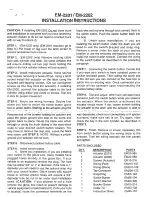
09 Wheels and tires
09
}}
261
Loading specifications
Properly loading your vehicle will provide
maximum return of vehicle design perform-
ance.
Before loading your vehicle, familiarize your-
self with the following terms for determining
your vehicle's weight ratings, with or without
a trailer, from the vehicle's Federal/Canadian
Motor Vehicle Safety Standards (FMVSS/
CMVSS) label, and the vehicle's tire informa-
tion placard:
Curb weight
The weight of the vehicle including a full tank
of fuel and all standard equipment. It does
not include passengers, cargo, or optional
equipment.
Capacity weight
All weight added to the curb weight, including
cargo and optional equipment. When towing,
trailer hitch tongue load is also part of cargo
weight.
Permissible axle weight
The maximum allowable weight that can be
carried by a single axle (front or rear). These
numbers are shown on the Federal/Canadian
Motor Vehicle Safety Standards (FMVSS/
CMVSS) label. The total load on each axle
must never exceed its maximum permissible
weight.
Gross vehicle weight (GVW)
The vehicle's curb cargo + passen-
gers.
•
The location of the various labels in
your vehicle, see Label information
•
A table listing important weight limits
for your vehicle, see Weights (p. 320).
Loading specifications – load limit
The load limit of your vehicle is the combined
weight of the occupants and cargo.
Steps for Determining Correct Load
Limit
1. Locate the statement "the combined
weight of occupants and cargo should
never exceed XXX pounds" on your vehi-
cle's placard.
2. Determine the combined weight of the
driver and passengers that will be riding
in your vehicle.
3. Subtract the combined weight of the
driver and passengers from XXX kilo-
grams or XXX pounds.
4. The resulting figure equals the available
amount of cargo and luggage load
capacity. For example, if the "XXX"
amount equals 1400 lbs. and there will be
five 150 lb. passengers in your vehicle,
the amount of available cargo and lug-
gage load capacity is 650 lbs. (1400 –
750 (5 × 150) = 650 lbs.)
5. Determine the combined weight of lug-
gage and cargo being loaded on the vehi-
cle. That weight may not safely exceed
the available cargo and luggage load
capacity calculated in Step 4.
Summary of Contents for 2016 s60 inscription
Page 1: ...WEB EDITION OWNER S MANUAL ...
Page 2: ......
Page 11: ...Contents 9 12 12 Index Index 332 ...
Page 12: ...INTRODUCTION ...
Page 27: ...SAFETY ...
Page 59: ...INSTRUMENTS AND CONTROLS ...
Page 108: ...CLIMATE ...
Page 120: ...LOADING AND STORAGE ...
Page 125: ...LOCKS AND ALARM ...
Page 142: ...DRIVER SUPPORT ...
Page 212: ...STARTING AND DRIVING ...
Page 236: ... 08 Starting and driving 08 234 Parking brake symbols and messages p 235 Brakes general p 228 ...
Page 250: ...WHEELS AND TIRES ...
Page 282: ...MAINTENANCE AND SERVICING ...
Page 316: ...SPECIFICATIONS ...
Page 318: ... 11 Specifications 11 316 Location of labels ...
Page 333: ...11 Specifications 11 331 ...
Page 342: ...12 Index 12 340 ...
Page 343: ......
















































